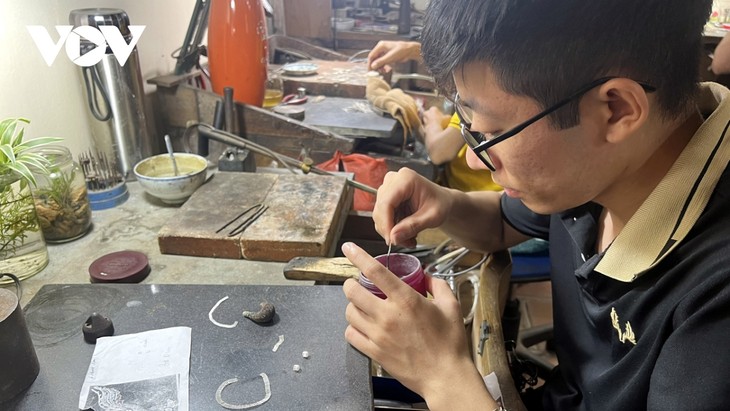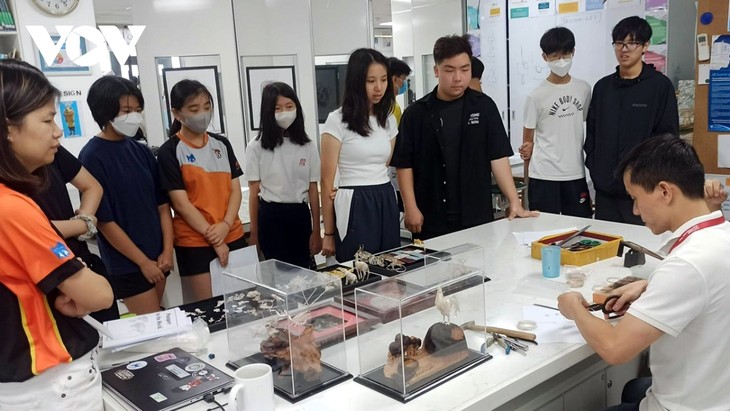Dinh Cong silver craft village in Hoang Mai district, Ha Noi, dates back to the 7th century. Through ups and downs, with the perseverance, and dedication of local talented artisans, the traditional silver making craft of Dinh Cong has been restored, passed down, and become a unique feature of thousand-year-old Ha Noi.

Silversmiths at Dinh Cong silver workshop
The workshop winding thin silver strings to make up shapes, patterns, or fine details of silver products owned by Quach Phan Tuan Anh, son of famous silversmith Quach Van Truong, is located in the precinct of the Dinh Cong village communal house. Truong is considered to have laid the foundation for the restoration of the traditional silver making craft of Dinh Cong.
The workshop has dozens of workers making sophisticated silverware. Starting with silver ingots, the workers skillfully design shapes, spin silver into thin threads, and braid the silver threads into products.
Tuan Anh explains while instructing the workers, “This is a bracelet which takes at least a week to 10 days to complete. I spun a large silver ingot into strands and designed patterns according to the customer's wishes.”
Le Dinh Son of the Dinh Cong silver workshop said it takes many days and requires good skills for workers to produce satisfactory handmade silver products.
“I'm making a logo. In the preparation process, I’ll use large silver threads to make a frame. To ensure its strength, small threads are used inside to fix the frame. Then small threads will be spun together to make patterns and motifs inside to create a finished product like this,” Son recalled.

“Dau bac” silver products of Dinh Cong village
According to local workers, creating a product as sophisticated in every small detail as the products in the workshop is impossible if workers don’t have passion and creativity. The craftsmen must understand four basic techniques - smoothing, combining, sculpting, and pulling. Smoothing is polishing products and creating standard shapes.
Combining is joining product details harmoniously and ensuring they are well-proportioned. Sculpting is drawing and carving fine patterns in the products. Pulling is drawing hot melted silver threads, which are as fine as strands of hair to make patterns or shapes of animals or flowers to attach to a product.
Of these steps, pulling requires the most skillful hands to create beautiful products with harmonious details.
Mai Hong Hanh, who works in the craft village, said that she is a native villager and decided to quit a job in a state agency to follow the craft. “It’s not simply because of the income. I want to work with village craftsmen like Tuan Anh, who has a development direction for the craft village and wants to pass the craft on to future generations,” said Hanh.
In addition to popular jewelry products, Dinh Cong artisans have developed a line of silver paintings which feature iconic images of Ha Noi such as Khue Van Cac, the pavilion of the constellation of literature in the Temple of Literature, Turtle Tower, and Ha Noi’s downtown.
The authorities of Ha Noi city and Hoang Mai district have organized free vocational training classes for young locals to preserve the traditional craft. The 35 trainees, after becoming proficient, will be the main human resource for the 1,500-year-old silver craft village.
Nguyen Thi Phuong, Chairwoman of the People's Committee of Dinh Cong ward, Hoang Mai district, said, “The local government has worked to restore and maintain the craft village and pass down the traditional occupation, which can help locals make a living.”
“When there are lots of orders, more people will get involved with the craft. We hope there will be a Dinh Cong silver brand in the future so we can combine the traditional craft village with tourism,” said Phuong.
Kim Thanh